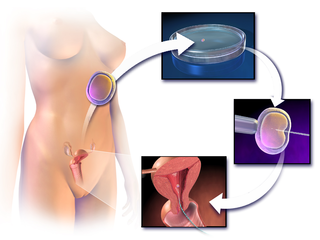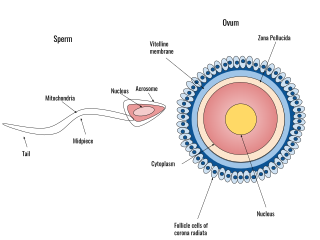Related Research Articles

A spermatozoon is a motile sperm cell, or moving form of the haploid cell that is the male gamete. A spermatozoon joins an ovum to form a zygote.

Fertilisation or fertilization, also known as generative fertilisation, syngamy and impregnation, is the fusion of gametes to give rise to a new individual organism or offspring and initiate its development. While processes such as insemination or pollination which happen before the fusion of gametes are also sometimes informally referred to as fertilisation, these are technically separate processes. The cycle of fertilisation and development of new individuals is called sexual reproduction. During double fertilisation in angiosperms the haploid male gamete combines with two haploid polar nuclei to form a triploid primary endosperm nucleus by the process of vegetative fertilisation.

In vitro fertilisation (IVF) is a process of fertilisation where an egg is combined with sperm in vitro. The process involves monitoring and stimulating a woman's ovulatory process, removing an ovum or ova from her ovaries and letting sperm fertilise them in a culture medium in a laboratory. After the fertilised egg (zygote) undergoes embryo culture for 2–6 days, it is transferred by catheter into the uterus, with the intention of establishing a successful pregnancy.

Intracytoplasmic sperm injection is an in vitro fertilization (IVF) procedure in which a single sperm cell is injected directly into the cytoplasm of an egg. This technique is used in order to prepare the gametes for the obtention of embryos that may be transferred to a maternal uterus. With this method, the acrosome reaction is skipped.

During fertilization, a sperm must first fuse with the plasma membrane and then penetrate the female egg cell to fertilize it. Fusing to the egg cell usually causes little problem, whereas penetrating through the egg's hard shell or extracellular matrix can be more difficult. Therefore, sperm cells go through a process known as the acrosome reaction, which is the reaction that occurs in the acrosome of the sperm as it approaches the egg.

The Human Fertilisation and Embryology Authority (HFEA) is an executive non-departmental public body of the Department of Health and Social Care in the United Kingdom. It is a statutory body that regulates and inspects all clinics in the United Kingdom providing in vitro fertilisation (IVF), artificial insemination and the storage of human eggs, sperm or embryos. It also regulates human embryo research.
Insemination is the introduction of sperm into a female’s reproductive system for the purpose of impregnating, also called fertilizing, the female for sexual reproduction. The sperm is introduced into the uterus of a mammal or the oviduct of an oviparous (egg-laying) animal. In mammals, insemination normally occurs during sexual intercourse or copulation, but insemination can take place in other ways, such as by artificial insemination.

The zona pellucida is a specialized extracellular matrix that surrounds the plasma membrane of mammalian oocytes. It is a vital constitutive part of the oocyte. The zona pellucida first appears in unilaminar primary oocytes. It is secreted by both the oocyte and the ovarian follicles. The zona pellucida is surrounded by the corona radiata. The corona is composed of cells that care for the egg when it is emitted from the ovary.

Acrosin is a digestive enzyme that acts as a protease. In humans, acrosin is encoded by the ACR gene. Acrosin is released from the acrosome of spermatozoa as a consequence of the acrosome reaction. It aids in the penetration of the Zona Pellucida.

Assisted reproductive technology (ART) includes medical procedures used primarily to address infertility. This subject involves procedures such as in vitro fertilization (IVF), intracytoplasmic sperm injection (ICSI), cryopreservation of gametes or embryos, and/or the use of fertility medication. When used to address infertility, ART may also be referred to as fertility treatment. ART mainly belongs to the field of reproductive endocrinology and infertility. Some forms of ART may be used with regard to fertile couples for genetic purpose. ART may also be used in surrogacy arrangements, although not all surrogacy arrangements involve ART. The existence of sterility will not always require ART to be the first option to consider, as there are occasions when its cause is a mild disorder that can be solved with more conventional treatments or with behaviors based on promoting health and reproductive habits.

Human fertilization is the union of a human egg and sperm, occurring primarily in the ampulla of the fallopian tube. The result of this union leads to the production of a fertilized egg called a zygote, initiating embryonic development. Scientists discovered the dynamics of human fertilization in the nineteenth century.

Human reproduction is sexual reproduction that results in human fertilization to produce a human offspring. It typically involves sexual intercourse between a sexually mature human male and female. During sexual intercourse, the interaction between the male and female reproductive systems results in fertilization of the ovum by the sperm to form a zygote. These specialized reproductive cells are called gametes, which are created in a process called gametogenesis. While normal cells contain 46 chromosomes, gamete cells only contain 23 single chromosomes, and it is when these two cells merge into one zygote cell that genetic recombination occurs and the new zygote contains 23 chromosomes from each parent, giving it 46 chromosomes. The zygote then undergoes a defined development process that is known as human embryogenesis, and this starts the typical 9-month gestation period that is followed by childbirth. The fertilization of the ovum may be achieved by artificial insemination methods, which do not involve sexual intercourse. Assisted reproductive technology also exists.

Fertility clinics are medical clinics that assist couples, and sometimes individuals, who want to become parents but for medical reasons have been unable to achieve this goal via the natural course. Clinics apply a number of diagnosis tests and sometimes very advanced medical treatments to achieve conceptions and pregnancies.
A humster is a hybrid cell line made from a hamster oocyte fertilized with human sperm. This is possible due to the unique promiscuity of hamster ova, which allows them to fuse with non-hamster sperm. It always consists of single cells, and cannot form a multi-cellular being. Humsters are usually destroyed before they divide into two cells; if isolated and left alone to divide, they would still be unviable.
Semen quality is a measure of male fertility, a measure of the ability of sperm in semen to accomplish fertilization. Semen quality involves both sperm quantity and quality. Semen quality is a major factor for fertility.
Pregnancy rate is the success rate for getting pregnant. It is the percentage of all attempts that leads to pregnancy, with attempts generally referring to menstrual cycles where insemination or any artificial equivalent is used, which may be simple artificial insemination (AI) or AI with additional in vitro fertilization (IVF).
Religious response to assisted reproductive technology deals with the new challenges for traditional social and religious communities raised by modern assisted reproductive technology. Because many religious communities have strong opinions and religious legislation regarding marriage, sex and reproduction, modern fertility technology has forced religions to respond.

Fertility testing is the process by which fertility is assessed, both generally and also to find the "fertile window" in the menstrual cycle. General health affects fertility, and STI testing is an important related field.
Jacques Cohen is a Dutch embryologist based in New York, U.S. He is currently Director at Reprogenetics LLC, Laboratory Director at ART Institute of Washington at Walter Reed National Military Medical Center, and Scientific Director of R & D at IVF-online.
Antisperm antibodies (ASA) are antibodies produced against sperm antigens.
References
- ↑ Mortimer, David (1994). Practical laboratory andrology. New York: Oxford University Press. pp. 221–237. ISBN 9780195065954.
- ↑ Padubidri; Daftary (2011). Shaw's Textbook of Gynaecology, 15e. p. 204. ISBN 9788131225486
- ↑ Peterson, C. Matthew; Jones, Kirtly Parker; Hatasaka, Harry H.; Wong, Kenneth H. H. (October 2002). "Hamster Egg Penetration Test" (PDF). University of Utah Health Sciences Center. Utah Center for Reproductive Medicine. Archived from the original (PDF) on 22 Jan 2019. Retrieved 17 April 2013.
- ↑ Koulischer L, Debry JM (1989). "[The hamster test. Practical consequences]". Acta Urol Belg (in French). 57 (1): 77–81. PMID 2718849.
- ↑ Peterson et al. 2002: "The human sperm does not fertilize the hamster eggs."
- ↑ Bonnicksen, Andrea (2009). Chimeras, Hybrids, and Interspecies Research Politics and Policymaking. Georgetown University Press. p. 62. ISBN 9781589015746.
- ↑ Final Report of the Human Embryo Research Panel (Report). Bethesda, MD: National Institutes of Health. 27 September 1994. As cited in Bonnicksen 2009.
- ↑ "Human Fertilisation and Embryology Act 1990, Schedule 2, Section 1(1)(f)".
- ↑ Yang, YS; Rojas, FJ; Stone, SC (Dec 1988). "Acrosome reaction of human spermatozoa in zona-free hamster egg penetration test". Fertility and Sterility. 50 (6): 954–9. doi:10.1016/S0015-0282(16)60380-1. PMID 3203761.
- 1 2 Zainul Rashid, MR; Fishel, SB; Thornton, S; Hall, JA; Ndukwe, G; Aloum, M; Fleming, SD (Mar 1998). "The predictive value of the zona-free hamster egg penetration test in relation to in-vitro fertilization at various insemination concentrations". Human Reproduction (Oxford, England). 13 (3): 624–9. doi: 10.1093/humrep/13.3.624 . PMID 9572423.
- ↑ Osser, S; Wramsby, H; Liedholm, P (May–Jun 1988). "A comparison between the hamster egg penetration test and the seminal parameters in men of infertile couples". International Journal of Fertility. 33 (3): 207–11. PMID 2899568.
- ↑ Koulischer L, Debry JM (1989). "The hamster test. Practical consequences". Acta Urologica Belgica (in French). 57 (1): 77–81. PMID 2718849.